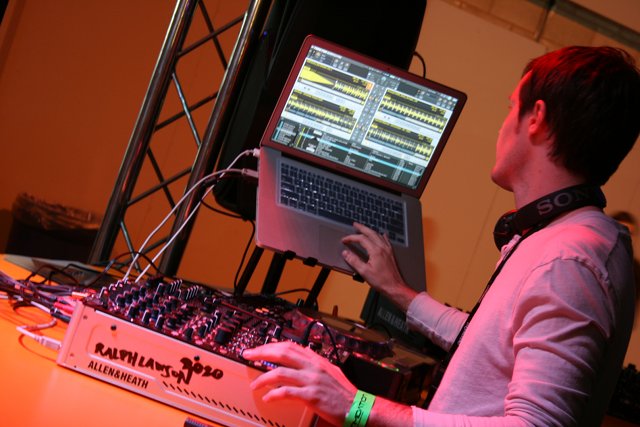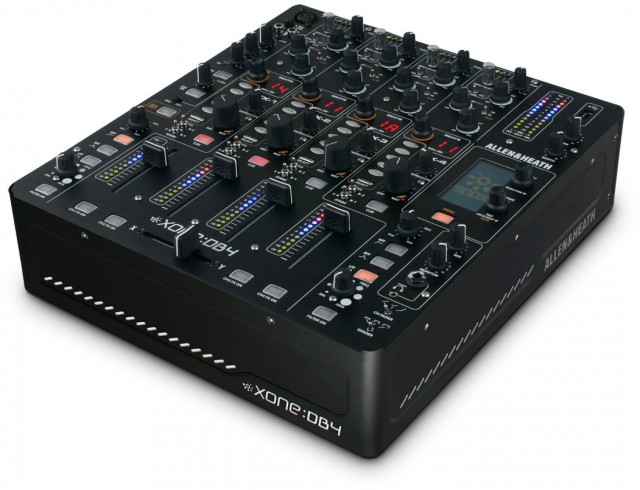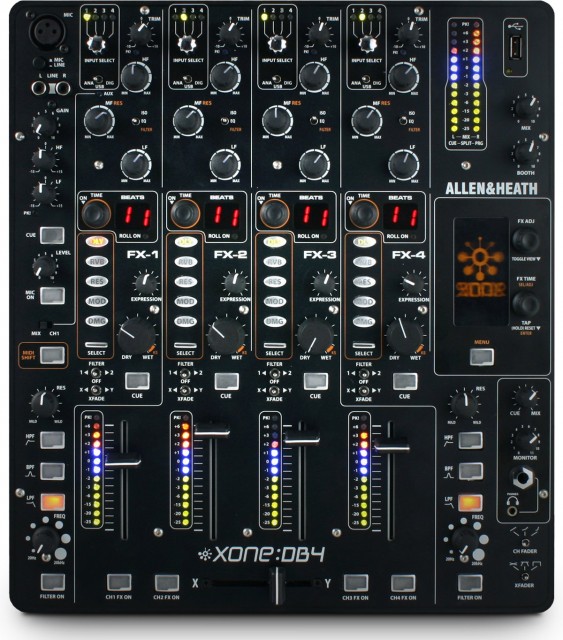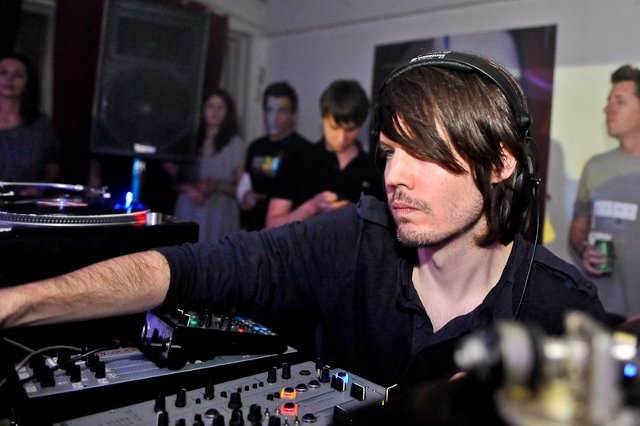Can a digital mixer change how you work and perform? After getting a hands-on introduction to one, globe-trotting electronic DJ Kevin McHugh, aka Ambivalent (on m-nus), thinks so. I’m pleased to welcome Kevin to talk about why he’s so excited about this particular kit, not only for DJs but potentially as a useful tool for anyone who needs live mixing. And we hope he’ll come back and talk to us regularly, in the midst of that jet-setting routine. In the meantime, we’ll see if he starts a Pioneer/Allen & Heath flame war. Side note: yes, in response to those in comments, we have to get someone to have a look at the Rane / Serato Sixty-Eight, too. -Ed.
The art of DJing has changed quite a bit in the past decade, giving us a ton of new playback and effects options with digital technology. But strangely, the central instrument of any DJ, the mixer, hasn’t fully stepped into the digital age. If there’s a solution, I got a brief introduction to it at the BPM trade show in Birmingham a few weeks ago.
Allen & Heath unveiled the working prototype for their new digital DJ mixer, the Xone DB4. They invited me and a few others to take it for a few laps around the track in their booth at the show, so I figured I’d share what I learned. I played with a prototype model that is still in the process of being finalized, so please don’t take this as the final word on the DB4. Things change, and it’d be unfair to award or deduct points for something it might or might not be when it is available. Also, the ultimate test of a mixer is how it sounds. While I know that A&H mixers have always sounded better to my ears than any others, I was unable to judge in a convention hall.
That said, I got a pretty decent taste of what it should offer when it’s out. Here’s the key stuff to know about the DB4.
Full disclosure: I’m an Allen & Heath fan both in the studio and in the DJ booth. I love the Xone products, and the Xone 92 has been the essential piece of every technical rider I’ve had in the last 4 years. It’s packed with useful features, great routing options, and sounds fantastic. Before I saw the DB4, I was just expecting to smile and nod politely, as the 92 is a monumental classic, and nearly impossible to improve upon. Like a Deadmau5 remix of the Factory Records catalogue, some classics are just better left alone. I figured I’d make some curious facial expressions, tap some buttons, and make some clever observations about “the future” while remaining firmly planted in the present. What I didn’t expect was to go home completely rethinking my approach to routing, FX, and gear, or that I’d be anxious for more time with one of these freakboxes.
First impressions
The DB4 is fashionably black, and every single centimeter of it is covered with buttons, knobs, displays and lights. If the Death Star had a DJ booth, Vader would be rocking this one. They’ve stayed mostly true to the 92’s layout, with a portion of the real-estate shared for the digital effects section (more on that later).
Let’s start with routing, since that’s where any DJ will first encounter the new options offered by the DB4. The four main channels can be accessed using one of three different methods:
- Standard analog inputs with phono or line impedance
- Digital inputs via four S/PDIF connections
- USB 2.0 connection to the mixer’s internal, 24-bit/96kHz soundcard.
Inputs
This is where the mixer gets interesting. Yes, a digital DJ can solve all their cabling and I/O hassles with just one USB cable — that’s something offered by other solutions. But after you’ve done that, the DB4 still leaves room to be connected simultaneously to several of your closest friends, rivals, or strangers. I have to say this is one part that makes my heart spin. The stress of cabling and re-cabling, navigating the input, output, channels or effects of other cohorts can make a cozy DJ booth into a claustrophobic scavenger hunt. If you’ve ever had to decide how to route a vinyl setup on top of a digital rig without a break in the music, using only a flashlight, you know what this means.
Where A&H have gotten really clever is how to treat these inputs on the top of the faceplate. Each channel has the option to select which source it’s using. Select the source type, then which input you’re assigning and you’ve just rerouted without touching a cable. This means channel 1 could carry analog input 4 and switch to USB input 2 in two shakes. It also means I don’t have to memorize the schematic of this mixers connections or fumble in the dark for the proper insertion point. (No jokes here; we’re keeping this clean.)
Output
The outputs are pretty standard, with analog booth, main, and record outputs. The nice surprise is a digital record out, making it easy to hook up to any ADAT or other S/PDIF-equipped interface. Pioneer users might also like the four deck starts offered. Having never used them, I can’t offer much insight about them, but it may give the DB4 a shot at winning over Pioneer users who haven’t already seen the light. (Hear that? That’s the sound of my inbox bursting into flames…)
EQ
The next thing I noticed is a difference in the EQ section. Here again, I was in for a big surprise. My initial disappointment at the loss of my Xone 92’s classic 4-band EQ was replaced with shock at how many new options were in its place. The three bands each have 3 separate functions, switchable between standard 3-band EQs, isolators, or a filter section with Hi-pass and Lo-pass, with the Mid frequency knob shifting to a resonance pot. What’s more, the knobs have a special backlight, so that the white position-indicators glow in a dark club. The thought of all these different options gives me dry mouth and heavy eyelids. Imagine Homer thinking about donuts…
Loopers
Each channel has its own looper with BPM detection that automatically records a 4-bar loop. The loop length can then be played back anywhere from 1/16 to the full 4 bars. For Traktor users, this won’t be necessarily a revolution, but other setups could really benefit. Somebody clever will no doubt find a way to combine this feature with the routing matrix and/or the effects to tap some options that aren’t obvious at first sight. That clever individual will never thank me, and pretend he or she never read this, but will think of me when they lie awake at night. It’s okay. I’m used to it.
FX
Other digital mixers so far have ended up being combination controllers/audio interfaces, which is fine. To be honest, that’s about what I expected out of this unit before I saw it. But the FX section is where this thing becomes a wrecking machine. Powered by a quad-core DSP engine, linked to the BPM detector, and inserted on each channel, there is a big beefy ton of readily-accessible power here. Steroid-abuse level power. Sounds hot, right? Gets hotter. It’s actually the effects themselves that are so damn sweet. These are literally studio-quality effects. I’d normally use a UAD2 Quad to run an EMT 250 reverb emulation in my studio. Now it’s available across up to four instances on a DJ mixer. That’s one of a huge batch of reverbs and there are even more delays (ping pong, hi-pass or lo-pass filtered, matched to bpm or delay in milliseconds), resonators, modulators and damage (distortion, bit-crushing).
One of my favorite features of the effects is how the Dry/Wet knob’s maximum position transforms it into to a Kill Send mode. This is great for building a nice big rush, and then dropping it off by killing the signal while the effects decay out. Another enterprising reader will note this feature, and also never thank me. They will think of me when they are posing, arms spread, Tiesto-style on a festival stage in front of 50,000 people. It’s okay. I’m used to it.
MIDI
Add to this the fact that nearly every device on the unit can function simultaneously as a USB MIDI controller, making your faders and knobs into encoders, assignable to any software you’re using, and you’re into some serious hot cocoa. The MIDI Shift button also disconnects the FX controls from the effects and the loop encoders from the looper, adding more MIDI-assignable functions.
Ed.: Allen & Heath sends along some additional details on just how MIDI works on this mixer.
MIDI Shift mode disconnects the FX buttons from the FX units so they can be used to launch clips in Ableton, or control transport in Traktor (or whatever the user requires). It also disconnects the loop encoder from the looper enabling this to be used for browsing etc.
Pretty much all of the other controls on the surface (there are a few exceptions) permanently send MIDI (this even includes the EQ Mode, X-fade assign and filter assign switches).
Specs
From Allen & Heath:
- Quad FX Core DSP, providing separate effects bank, BPM detection and tempo adjustment on each channel
- Five FX types – delays, reverbs, modulators, resonators and damage – plus variations, expression, wet/dry
- One looper per channel, loop length from 1/16 beat to 4 bars
- Xone dual filter system.
- Sources: analog Line 1-4 (switchable to Phono on 2 – 3), Digital 1-4, or USB 1-4.
- 3-band EQ, configurable as standard asymmetric EQ (+6/-25dB), Isolator (+6dB/OFF with a 24dB/octave slope), or reconfigured as a High-Pass/Low-Pass filter system with adjustable resonance.
- Mic/Line input with 2-band EQ, gain, cue, and mix level, routable to channel 1 for adding FX.
- Sound card: 24-bit / 96kHz, multi-channel, fully patchable USB2 soundcard ,4 stereo sends and 4 stereo inputs
- USB patch storage: Meter mode, BPM range, USB audio routing scheme and display brightness can be saved to a USB key for recall on another :DB4.
- MIDI control without changing mixer settings
- Output: Booth, record and phones – source selectable and level trim. Booth and main – phase and level trim controls.
- OLED display, visible even in bright sunlight
- Lightweight aluminium chassis
Bad Cop
Here’s the part where I act real mean and try to break down the witness by showing them scary pictures and punching the table. Okay, I can’t really do that. Most of the differences between the DB4 and my beloved 92 are a positive improvement, or an worthwhile compromise, given what’s offered in return. There are definitely going to be risks in using a digital mixer. Digital devices can crash. But analog devices have their issues, too. It’s what Depeche Mode says, a question of lust, a question of trust. If you lust for serious options and DSP firepower, and trust that Allen & Heath have it worked out, you’re ready to start a beautiful relationship. Of course, there’s also a question of cost. This is definitely not priced for entry-level incomes, but chances are no one serious enough to consider this unit will be able to find something comparable.
I think it’s fair to say I’m enthusiastic about the possibilities created by this mixer. Much of it comes from the fact that it crosses beyond a passive audio summing device, and into a performance tool. Like any great design, it solves problems and opens doors. But even more than that, it moves us in the direction of a common platform where any DJ setup can cooperate and where the booth gains some of the power of the studio. Some DJs might blanch at the idea of having so many options and such a complex tool. I’d counter that if you believe DJing is performance, why would you limit the power of your instrument? And if you’re serious about meeting the musical future, you’re going to be looking right down the barrel of a device like this sooner or later.
I, for one, welcome our digital overlords.
More from Ambivalent, if you don’t already know and follow his body of work and DJing:
facebook.com/AmbivalentBeats
twitter.com/AmbivalentBeats
XONE:DB4 Mixer [A&H Product Page]




